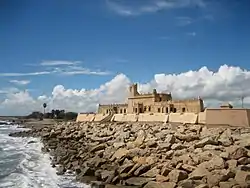
Colonial architecture is a hybrid architectural style that arose as colonists combined architectural styles from their country of origin with design characteristics of the settled country. Colonists frequently built houses and buildings in a style that was familiar to them but with local characteristics more suited to their new climate.[1]
In recent years, people in the interior design community are beginning to acknowledge the baggage the term might have - and to explore how the style may be appreciated whilst also acknowledging the harm and trauma of the Colonial era.[2]
Below are links to specific articles about colonial architecture, specifically the modern colonies:
Spanish colonial architecture
Spanish colonial architecture is still found in the former colonies of the Spanish Empire in the Americas and in the Philippines. In Mexico, it is found in the Historic center of Mexico City, Puebla, Zacatecas, Querétaro, Guanajuato, and Morelia. Antigua Guatemala in Guatemala is also known for its well-preserved Spanish colonial style architecture. Other cities known for Spanish colonial heritage are Ciudad Colonial of Santo Domingo, the ports of Cartagena, Colombia, and Old San Juan in Puerto Rico.
- North America

- Viceroyalty of New Spain
- Spanish Colonial architecture in Mexico
- Spanish Colonial architecture in the United States
- Spanish Colonial Revival architecture
- Caribbean
- Spanish West Indies
- Spanish Colonial architecture in Cuba
- Spanish Colonial architecture in the Dominican Republic
- Spanish Colonial architecture in Puerto Rico
- South America
- Viceroyalty of Peru, Viceroyalty of New Granada, and Viceroyalty of the Río de la Plata
- Spanish Colonial architecture in Argentina
- Spanish Colonial architecture in Chile
- Spanish Colonial architecture in Colombia
- Spanish Colonial architecture in Peru
- Spanish Colonial architecture in Venezuela
- Spanish missions in South America
- Spanish missions in Bolivia
- Spanish missions in Brazil
 Paoay Church Ilocos Sur Philippines is a fine example of Spanish Earthquake Baroque only found in the Philippines
Paoay Church Ilocos Sur Philippines is a fine example of Spanish Earthquake Baroque only found in the Philippines - Spanish missions in Paraguay
- Asia
- Spanish East Indies
- Spanish Colonial architecture in the Philippines
- Earthquake Baroque
- Bahay na Bato
Portuguese colonial architecture

b. 1498, Mozambique
Portuguese colonial architecture is most visible in Brazil, Madeira, North Africa and Sub-Saharan Africa, Macau, the Malaysian city of Malacca, city of Goa in India, and Moluccas and Java in Indonesia.
- Asia
- Portuguese colonial architecture in India
- Portuguese colonial architecture in Sri Lanka
- Sino-Portuguese architecture
- Centro Histórico de Macau
- South America
- Portuguese colonial architecture in Brazil
British colonial architecture


British colonial architecture are most visible in North America, the British West Indies, South Asia, Australia, New Zealand and South Africa.
- North America
- South Asia
- Australia
- Asia-Pacific
French colonial architecture
.jpg.webp)
French colonial architecture is most visible in North America and Indochina.
- Indochina
- North America
- South Asia
- French colonial architecture in India
Dutch colonial architecture

Dutch colonial architecture is most visible in Indonesia (especially Java and Sumatra), the United States, South Asia, and South Africa. In Indonesia, formerly Dutch East Indies, colonial architecture was studied academically and had developed into a new tropical architecture form which emphasizes on conforming to the tropical climate of the Indies and not completely imitating the architectural language of the Dutch colonists.
- Indonesia
- North America
- South Asia
- Dutch colonial architecture in India
- Colonial architecture in Sri Lanka
- South Africa
Italian colonial architecture
Italian colonial architecture is visible in Libya which was colonized by Italy after defeating the Ottoman Army in 1912 during the Italo-Turkish War with huge colonial architecture in the capital Tripoli and in other major cities like Benghazi and Misrata.
Eritrea an Italian colony from 1890 to 1941 when the British occupied it during world war 2 with prominent colonial architecture spanning from styles like Art Deco to Neoclassical architecture spread out from the capital Asmara to the smaller towns of Karen with Italian colonial architecture even being a huge tourist attraction of the country.
Somalia was an Italian colony from 1889 to 1941 and again from 1950 to 1960, like Eritrea Italian colonial architecture was spread out across the country in different architectural styles but with the civil war of 1991 and years of violence after most of the Italian colonial architecture being destroyed or decayed with nowadays only a few buildings existing such as the Vila Somalia where the president resides.
The Greek islands of the Dodecanese which was won over during the Italo - Turkish war like Libya with the largest city of the island Rhodes being built entirely by the Italian colonists and its main government buildings also being built by the Italian colonists.
See also
References
- ↑ Guaita, Ovidio (1999). On distant shores: colonial houses around the world. Monacelli Press. ISBN 9781580930512. Retrieved January 26, 2014.
world colonial architecture.
- ↑ "Five Problematic Design Terms You Should Retire or Rethink". House Beautiful. 2020-08-11. Retrieved 2023-01-07.
External links
Colonial architecture.
